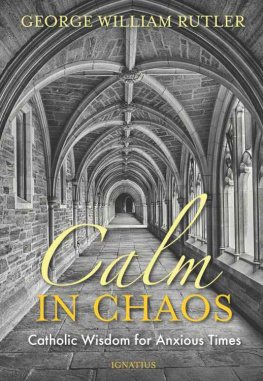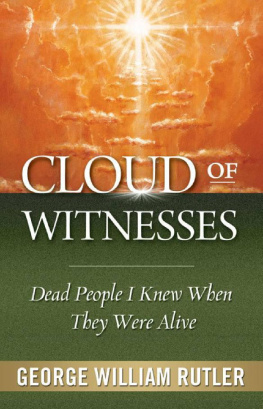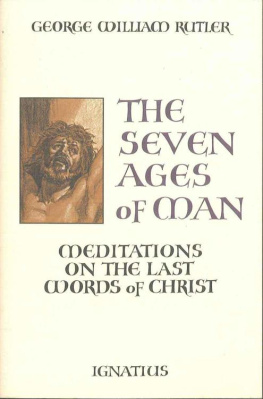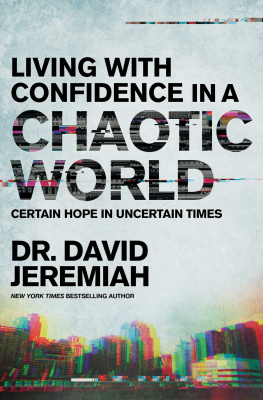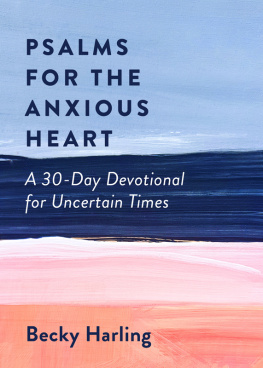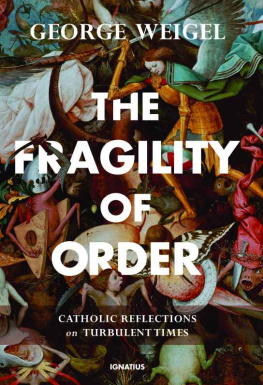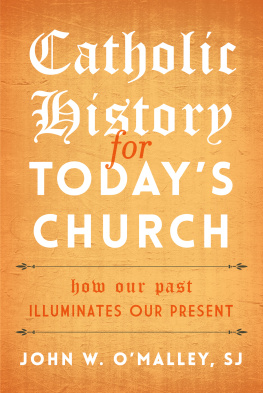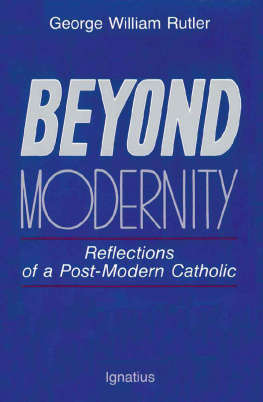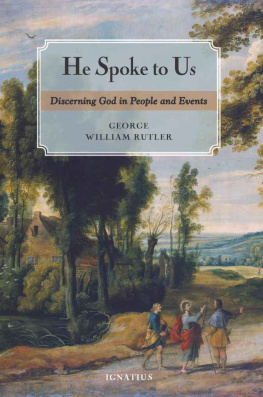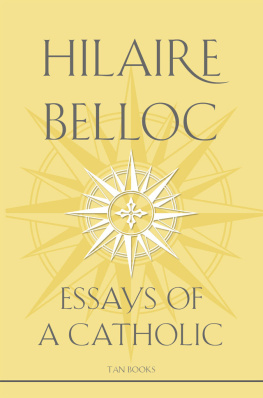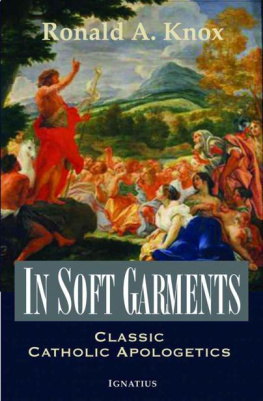CALM IN CHAOS
GEORGE WILLIAM RUTLER
Calm in Chaos
Essays for Anxious Times
IGNATIUS PRESS SAN FRANCISCO
Cover photograph:
Classic stone arched cloister walk
Unsplash.com/Dawn Armfield @darmfield
Cover design by Carl E. Olson
2018 by Ignatius Press, San Francisco
All rights reserved
ISBN 978-1-62164-236-7 (PB)
ISBN 978-1-64229-051-6 (EB)
Library of Congress Control Number 2018931250
Printed in the United States of America
Seeing then that these things cannot be contradicted, you ought to be quiet and do nothing rash.
Acts 19:36
CONTENTS
INTRODUCTION
A sure way to start a panic is to tell people not to panic, and of that in these next pages I may be guilty. There have been prophets in ancient and arid climes whose office was to stir the consciences of their tribes while spending their next breath to calm them with the promise of hope. So it has always been, and never more deftly put than when the Lord of history prepared his followers for the worst while promising the collateral best: You will be hated by all men for my names sake. But he who endures to the end will be saved (Mt 10:22).
Saints and demagogues have had plenty of opportunities to deal with social chaos around them, and the difference between them has been the way they dealt with it. At the turn of the first millennium, when the people of Rome were not as calm, quiet, and reasonable as they claim to be today, they were scandalized when Pope Sylvester II told them not to panic, for the world was not about to end. They thought he was a deluded optimist. In contrast, in 1914, when Sir Edward Grey said that the lamps were going out all over Europe, there were those basking in a halcyon summer light who thought he was impossibly pessimistic. It could be argued as we look around today that those lights have never been turned back on again, not if those lights were millions of young men denied a chance to build and compose and invent and have children and grow old.
The chapters that follow are neither pessimistic nor optimistic, because they are about the virtue of hope, and its promise is not psychological, nor is hope the disposition born of happy attitudes. God never promised anything less than a joy that is more than a contented temperament, for it is happiness compounded by happiness, a joy born of a peace that only he can give and that no earthly circumstance can take away (see Jn 15:27).
Even the hortatory manipulator of men, Thomas Paine, was right that his times did try mens souls. But that can be said of any age. Our times, though, with their vast interworking of populations and an exponential increase in ways of instantaneous messaging, are fraught with resignation to unresolvable confusion. Even the most trusted institutions seem, by their lack of systematic thought and discipline, to be engines of dissonance.
Sentimental personalities may find solace in Nietzsche: One must still have chaos in oneself to be able to give birth to a dancing star. The challenge now, however, is that we live on a planet that is not a star, and that dancing comes only after learning how to walk, and that Nietzsche himself died after eleven years of mental darkness.
In the precipitous anxiety of 1939, the British Ministry of Information printed nearly 2.5 million posters with the message Keep Calm and Carry On. The words were printed in bold, modernistic typeface similar to the Gill Sans font designed by Eric Gill, the tormented friend of G. K. Chesterton. But back then, the stalwart population with stiff upper lips had not degenerated into the neurotic culture with quivering lips that would, for instance, succumb to group hysteria at the death of celebrities symbolic of their illusory world. In 1939 the British working class who knew tough days also surmised that the well-intentioned government propagandists fresh from Eton and Oxford had underestimated their mettle. Very few of those posters actually were posted. The people did not need them, and they carried on in their finest hour. Today those posters are collectors items and are seen in variant forms on T-shirts and souvenir coffee cups. In the present cultural climate, domestically distraught by spiritual doubt and threatened by cynics disdainful of the Gospel, it is reasonable to trust that there will be those who stay calm and carry the day.
The following essays, which sometime refer to events that were current at the time the essays were first published online over the past several years, touch upon confusions in the Church that are not without precedent but that are on a uniquely global scale. If there is one underlying theme in this analysis of the chaos of our times, it is dismay at the lack of historical perspective, as it deprives people of the lessons that should have been learned after present conceits have been found wanting. The gremlin that haunts our times is not heresy as much as it is ignorance. Errors in matters of faith usually are the result not of willful contempt for Christ but of a failure to recall and understand the trial of human experience.
If there is one message in the following chapters, as they touch on various concerns of the day, it is Stay Calm. I say that not to cause panic in the room but to gather together the faithful in steady hope uncompromised by circumstance or diluted by mood, aware that in anxious moments Christ is not asleep. You of little faith, why are you so afraid? Then he got up and rebuked the winds and the waves, and it was completely calm. The men were amazed and asked, What kind of man is this? Even the winds and the waves obey him! (Mt 8:26-27).
Chapter 1
The Resurrection Difference
At the Yorktown surrender in 1781, the British band played a tune traditional to the ballad The World Turned Upside Down. In the 1640s the ballad had been written as a broadside against the suppression of Christmas festivities by the Puritan parliament. In some ways, the world had indeed been turned upside down, at least in the civil order. President Nixons unmeasured hyperbole had a measure of logic, at least for physics, when he called the days of the Apollo 11 moon landing the greatest week in the history of the world since Creation. There are seminal moments that rattle the course of history, and as in James Russell Lowells hymn, New occasions teach new duties, time makes ancient good uncouth. No event approaches the Resurrection of Christ in its effect on the world. It turned the world upside down; or, given the Fall of Man, it turned the world right side up again. A flaccid B.C.E./C.E. instead of B.C./A.D. anesthetizes consciousness of its importance.
When witnesses to the Resurrection, and their followers, became conspicuous in Rome, having found a name for themselves in Antioch as Christians, the imperial establishment scorned them for contemptissima inertia , which most disgusting laziness was in fact modesty, rejection of divorce, indifference to public honors and celebrity, failure to attend the gross entertainments of the circus, and refusal to abort babies. It was inconceivable to the Roman culture, expressed by its temple cults, that religion should have anything to do with morals. There was a complex system of priests with flamines leading the worship of particular gods, pontifices supervising the whole system and preserving the pax deorum or religious order, and a rex sacrorum who supervised the feasts.
That basic sacral structure of the old Republic was altered after Julius Caesar arrogated to himself the role of Pontifex Maximus, not to mention divinity. Before then, the lifelong office had been conferred by a Comitia Tributa, but it devolved into an almost ex officio role of the emperors. Then there were the augurs who daily examined the behavior of birds and the haruspices who divined with animal entrails to recommend courses of action. The whole system, however, was based on orthopraxy rather than orthodoxy: there was no creed, rituals had nothing to do with dogma, and the rituals themselves consisted of a pedantic and coarse economy of bartering with the gods for favors ( noncupatio ), in return for which some gift or favor ( solutio ) was promised.
Next page
